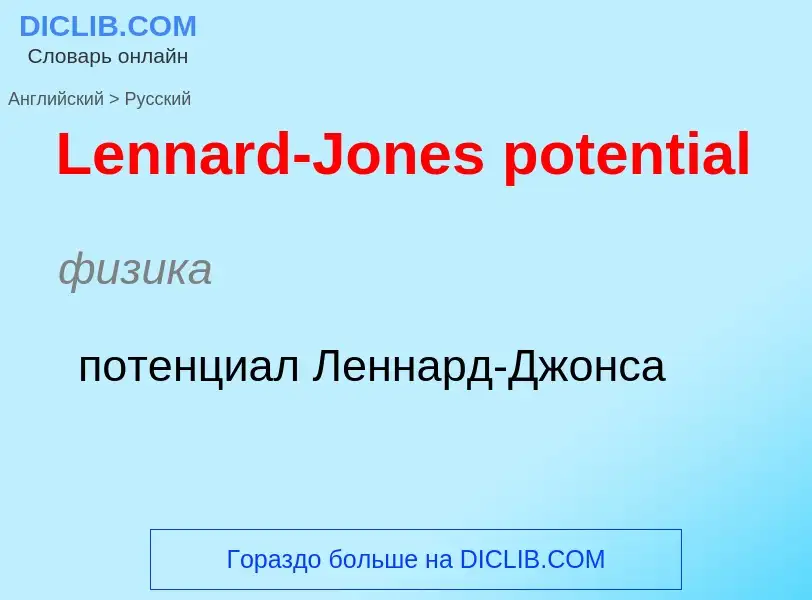Traduzione e analisi delle parole tramite l'intelligenza artificiale ChatGPT
In questa pagina puoi ottenere un'analisi dettagliata di una parola o frase, prodotta utilizzando la migliore tecnologia di intelligenza artificiale fino ad oggi:
- come viene usata la parola
- frequenza di utilizzo
- è usato più spesso nel discorso orale o scritto
- opzioni di traduzione delle parole
- esempi di utilizzo (varie frasi con traduzione)
- etimologia
Lennard-Jones potential - traduzione in russo
физика
потенциал Леннард-Джонса
[,pi:tə'dʒəunz]
общая лексика
"Питер Джоунз" (большой универсальный магазин преим. женской одежды и принадлежностей женского туалета в Лондоне; контролируется холдинг-компанией "Джон Льюис" [John Lewis])
электроника
кулоновский потенциал
Definizione
Wikipedia

In computational chemistry, the Lennard-Jones potential (also termed the LJ potential or 12-6 potential; named for John Lennard-Jones) is an intermolecular pair potential. Out of all the intermolecular potentials, the Lennard-Jones potential is probably the one that has been the most extensively studied. It is considered an archetype model for simple yet realistic intermolecular interactions.
The Lennard-Jones potential models soft repulsive and attractive (van der Waals) interactions. Hence, the Lennard-Jones potential describes electronically neutral atoms or molecules. The commonly used expression for the Lennard-Jones potential is
where r is the distance between two interacting particles, ε is the depth of the potential well (usually referred to as 'dispersion energy'), and σ is the distance at which the particle-particle potential energy V is zero (often referred to as 'size of the particle'). The Lennard-Jones potential has its minimum at a distance of where the potential energy has the valueThe Lennard-Jones potential is a simplified model that yet describes the essential features of interactions between simple atoms and molecules: Two interacting particles repel each other at very close distance, attract each other at moderate distance, and do not interact at infinite distance, as shown in Figure 1. The Lennard-Jones potential is a pair potential, i.e. no three- or multi-body interactions are covered by the potential.
Statistical mechanics and computer simulations can be used to study the Lennard-Jones potential and to obtain thermophysical properties of the 'Lennard-Jones substance'. The Lennard-Jones substance is often referred to as 'Lennard-Jonesium' suggesting that it is viewed as a (fictive) chemical element. Moreover, its energy and length parameters can be adjusted to fit many different real substances. Both the Lennard-Jones potential and, accordingly, the Lennard-Jones substance are simplified yet realistic models, such as they accurately capture essential physical principles like the presence of a critical and a triple point, condensation and freezing. Due in part to its mathematical simplicity, the Lennard-Jones potential has been extensively used in studies on matter since the early days of computer simulation. The Lennard-Jones potential is probably still the most frequently studied model potential.
The Lennard-Jones potential is usually the standard choice for the development of theories for matter (especially soft-matter) as well as for the development and testing of computational methods and algorithms. Upon adjusting the model parameters ε and σ to real substance properties, the Lennard-Jones potential can be used to describe simple substance (like noble gases) with good accuracy. Furthermore, the Lennard-Jones potential is often used as a building block in molecular models (a.k.a. force fields) for more complex substances.





!['''Figure 6'''. Vapor–liquid equilibria of binary Lennard-Jones mixtures. In all shown cases, component 2 is the more volatile component (enriching in the vapor phase). The units are given in <math>\varepsilon</math> and <math>\sigma</math> of component 1, which is the same in all four shown mixtures. The temperature is <math>T=0.92\,\varepsilon k_\mathrm{B}^{-1}</math>. Symbols are molecular simulation results and lines are results from an [[equation of state]]. Data taken from Ref.<ref name="Stephan e1699185"/> '''Figure 6'''. Vapor–liquid equilibria of binary Lennard-Jones mixtures. In all shown cases, component 2 is the more volatile component (enriching in the vapor phase). The units are given in <math>\varepsilon</math> and <math>\sigma</math> of component 1, which is the same in all four shown mixtures. The temperature is <math>T=0.92\,\varepsilon k_\mathrm{B}^{-1}</math>. Symbols are molecular simulation results and lines are results from an [[equation of state]]. Data taken from Ref.<ref name="Stephan e1699185"/>](https://commons.wikimedia.org/wiki/Special:FilePath/LJ mixtures.png?width=200)




